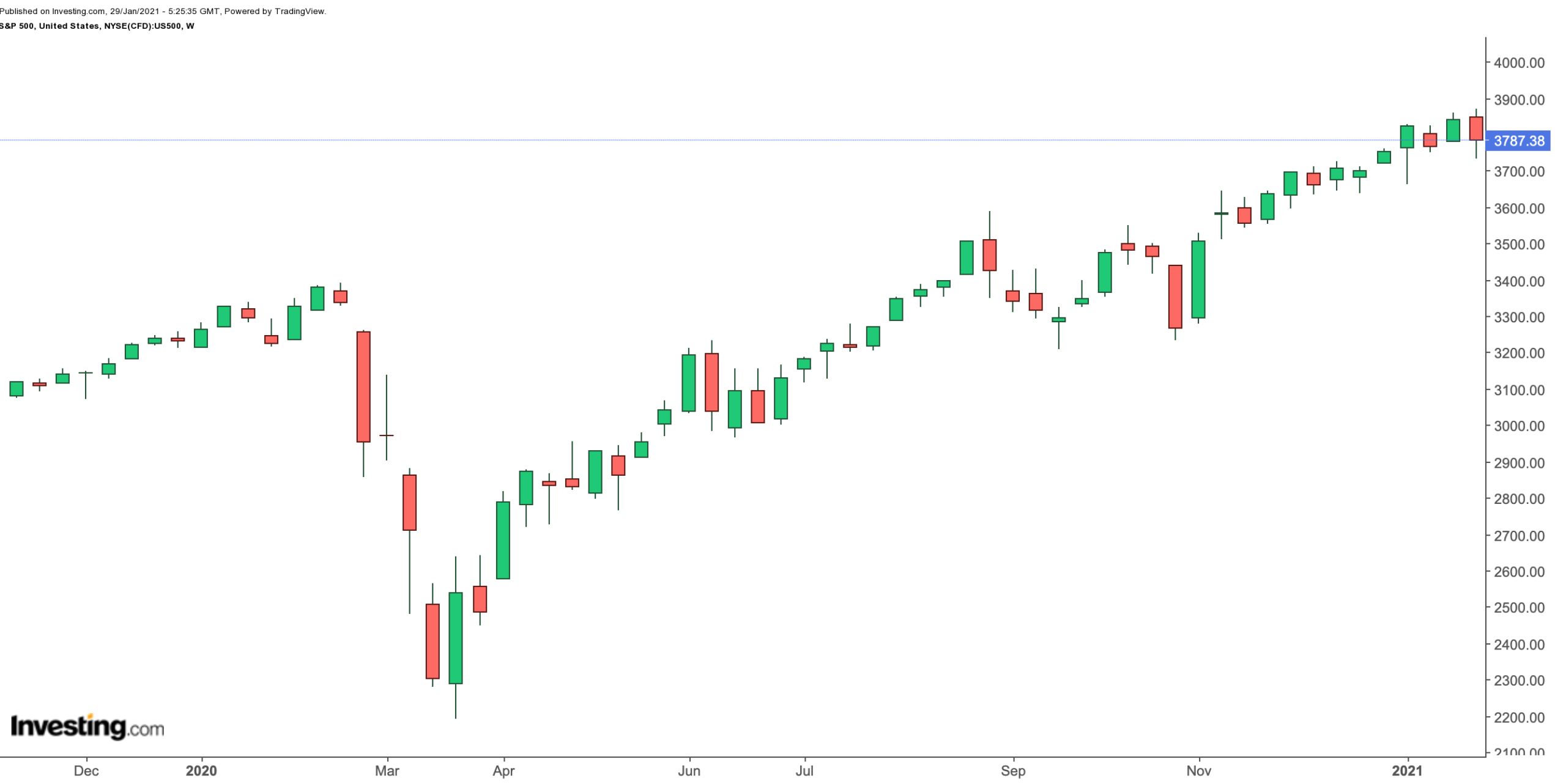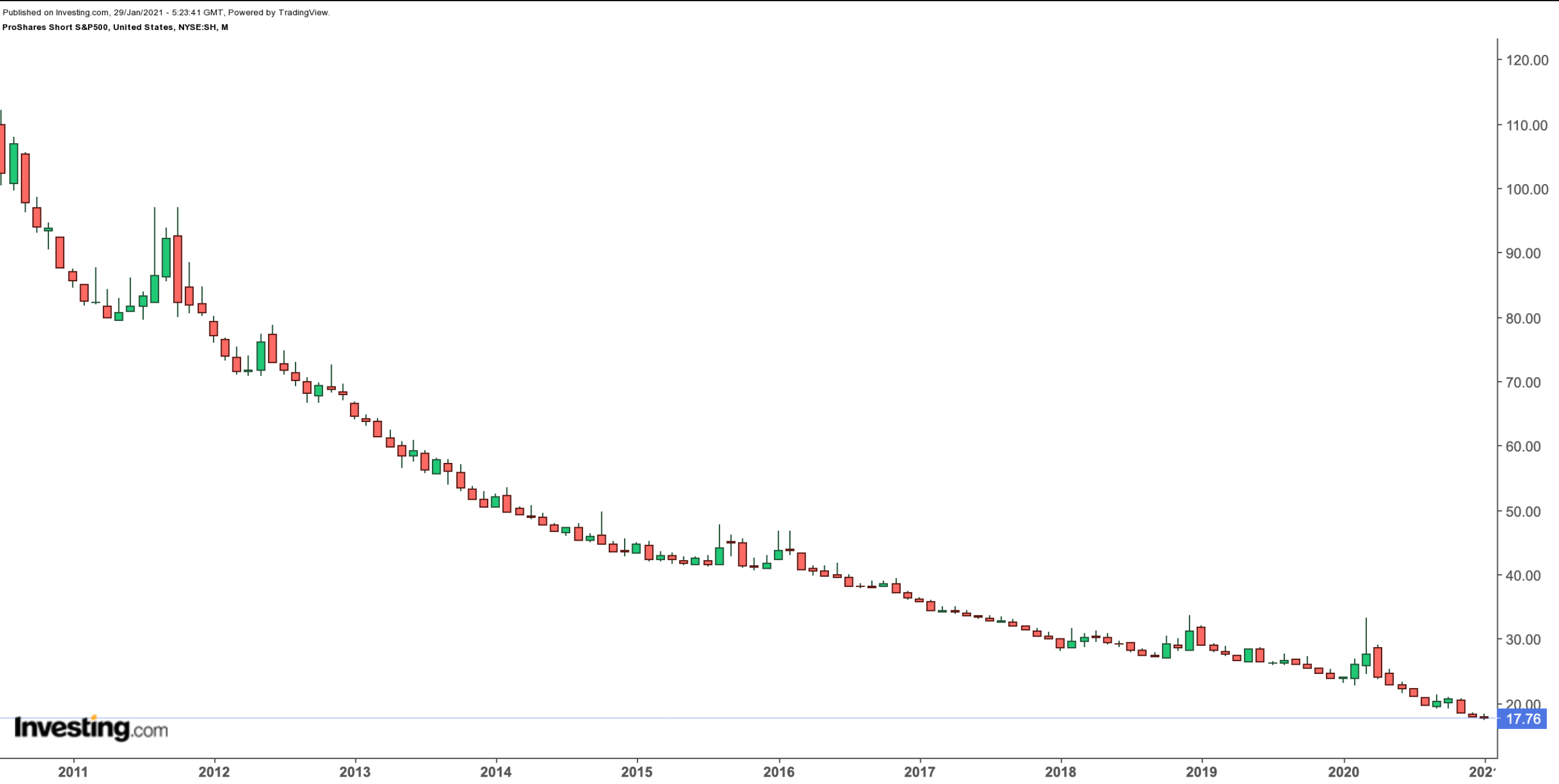The earnings season has brought increased volatility as well as downward pressure on broader U.S. indices. As of yesterday, the S&P 500 index has now given up the 2021 gains and is in negative territory for January. The index is seen as a good barometer of the overall stock market’s performance.

In 2020, however, the S&P 500 returned more than 16%, highlighting the importance of investing for the long-run for most retail investors, without worrying about the market’s short-term swings. Over the past 52 weeks, the index has increased by 15%.
Similarly, the SPDR S&P 500 ETF Trust (ASX:SPY), an exchange-traded fund (ETF) that provides exposure to the index, is also up about 15% in the past year. In January 1993, SPY (NYSE:SPY) became the first ETF to be launched stateside. It is also the largest one at present.

However, what if investors want to book some downside profits if there is a big leg lower, for example, in the S&P 500? Is there a financial instrument that can achieve that goal?
Inverse (or short) ETFs are among such products, as their value increases if the corresponding benchmark index falls.
Today, we discuss the important general characteristics of inverse ETFs and introduces one such fund that might appeal to those looking for inverse short (bearish) exposure to daily returns on the S&P 500.
Risk-Return Tradeoff
Inverse ETFs provide short exposure to the daily return of various indices, sectors or asset classes.
There are also leveraged (or geared) inverse ETFs offering −2× or −3× the underlying index returns. In such funds, risks and returns become turbo-charged.
In order to achieve the desired daily effect of “long negative exposure,” inverse funds typically hold complex derivative products, like swaps, futures and options.
Due to the compounding of daily returns, which we have covered in detail, any longer holding period could easily result in returns that significantly differ from the target. Therefore, for holding periods longer than a trading day, an inverse fund may not necessarily move inversely to the corresponding index.
Over longer periods, time decay and the negative rebalancing effect come into play. Thus, these inverse and (inverse) leveraged ETFs are more appropriate for short-term trading as opposed to long-term investing.
It’s important to highlight that these products offer the possibility of shorting the market without the risk of unlimited losses. In the past several weeks, the moves in the price of GameStop (NYSE:GME) stock have underlined the potential effect of short-covering.
This week has clearly shown when a stock is shorted, those taking the short position are exposed to that position going infinitely higher. In the case of an inverse ETF, the losses would be limited to the amount that the trader initially invested into the position.
While inverse funds can be effective hedging tools, traders would need to monitor portfolios carefully and possibly rebalance positions to maintain the hedge. On a final note, these funds typically have high expense ratios.
ProShares Short S&P 500
- Current Price: $17.76
- 52-Week Range: $17.39 - $33.19
- Expense Ratio: 0.90%
The ProShares Short S&P500 (NYSE:SH) seeks daily investment results that correspond to the inverse (-1x) of the daily performance of the S&P 500 index.

Over the past 12 months, SH dropped about 25%, while the S&P 500 as well as SPY both increased around 15%. This difference in (inverse) returns shows us the daily hedging purpose of the fund.
The fund first started trading in June 2006. A longer-term chart shows the loss in the value of the fund.

Put another way, SH might initially look like a relatively straightforward ETF, allowing a non-leveraged shorting (-1x) of the S&P 500 index.
However, SH would generally be recommended only as a short-term trade. It should ideally be a relatively small holding in a more substantial portfolio.
Bottom Line
An inverse ETF like SH might provide market participants with some hedging tools or advantages. However, it can also lead to significant losses.
Inverse and leveraged (inverse) ETFs are typically not suitable for buy-and-hold investors since the long-run returns can be significantly below that of the underlying index.
Those investors who want to hedge some portfolio risk or have a bearish opinion on a certain market index or asset class may consider several other inverse exchange-traded funds, including:
Direxion Daily Junior Gold Miners Index Bear 2X Shares (NYSE:JDST)
Direxion Daily S&P 500® Bear 1X Shares (NYSE:SPDN)
MicroSectors US Big Banks Index 2X Inverse Leveraged (NYSE:BNKZ)
ProShares UltraShort MSCI Emerging Markets (NYSE:EEV)
ProShares UltraPro Short QQQ (NASDAQ:SQQQ)
ProShares UltraPro Short S&P500 (NYSE:SPXU)
Retail investors interested in inverse ETFs should consider talking to a registered financial adviser in their respective jurisdictions.
